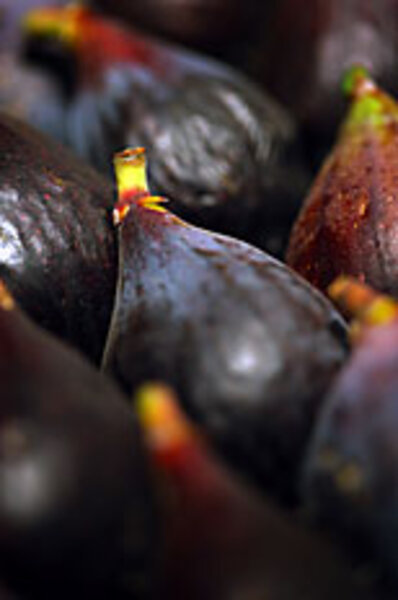Fabulous figs
Loading...
| Plymouth, Mass.
The Newtons. What a wonderfully diverse family. We all know of Sir Isaac, and his affinity for mathematics, physics, and apples. Then there's Wayne, "Mr. Las Vegas." (Never seen him. Never care to.) And that most popular family member, and my close childhood companion, Fig.
Fig Newtons were a staple in my parents' home. They were the one store-bought cookie that Mother thought worthy of dessert. "Eat them; they're good for you," she'd say as she passed them around the dinner table. And when other kids were pulling Twinkies from their Roy Rogers lunchboxes at school, my soggy tuna sandwich was accompanied by a couple of … guess what?
As an adult, my fondness for fresh figs is an ongoing culinary adventure. It began a number of years ago when I purchased a young fig tree from a local nursery. My tender shrub wasn't fit for wintering in the outdoors in the chilly Northeast, but it thrived in my greenhouse. The yield was scant, cherished, sweet, juicy, and delicious. It didn't take long for me to become a convert.
Ten years ago, fresh figs were rarely available in supermarkets unless you lived in California, where most figs in the United States are grown.
Historically, they are an ancient fruit, going back thousands of years to Asia, through Egypt, into the Mediterranean, and finally to the US, where they were brought to California by Spanish missionaries in the 1500s.
Along with grapes, they are mentioned more than any other fruit in the Bible and, according to many biblical scholars, were the forbidden fruit in the Garden of Eden. The Bible never mentions exactly what fruit Eve plucked from the Tree of Knowledge of Good and Evil, but in the following verse Genesis records: "At that moment their eyes were opened, and they suddenly felt shame at their nakedness. So they sewed fig leaves together to cover themselves" (Gen. 3:7).
Fig leaves continued to be a fashion statement in museums where modest Victorians kept nude male Greek statues from blushing by adorning them with fig leaves.
The mythological founders of Rome, Romulus and Remus, were suckled by a she-wolf under a fig tree. And Siddhartha Gautama had the revelation that formed the foundations of Buddhism while meditating under a fig tree.
Spanish missionaries brought the fruit to the New World in the early 1500s. From South America they were introduced to California.
Mediterranean countries, Italy and Spain in particular, have always had a fondness for them. The best figs I've ever eaten were in the Emilia-Romagna region of Italy, where they were served with mascarpone cheese, warm hazelnut sauce, and chocolate.
Dried figs are available year-round, and may be soaked and stewed like any other dried fruit. Fresh figs are becoming more available, but the season is short, usually from August through early October.
Fresh figs may be dark purple or pale green, depending on the variety. They are very fragile and can be pricey, so inspect them carefully before buying. They should be slightly soft and free of any bruises, blemishes, or white powdery bloom. A fig that's past its prime will have a nasty fermented odor.





